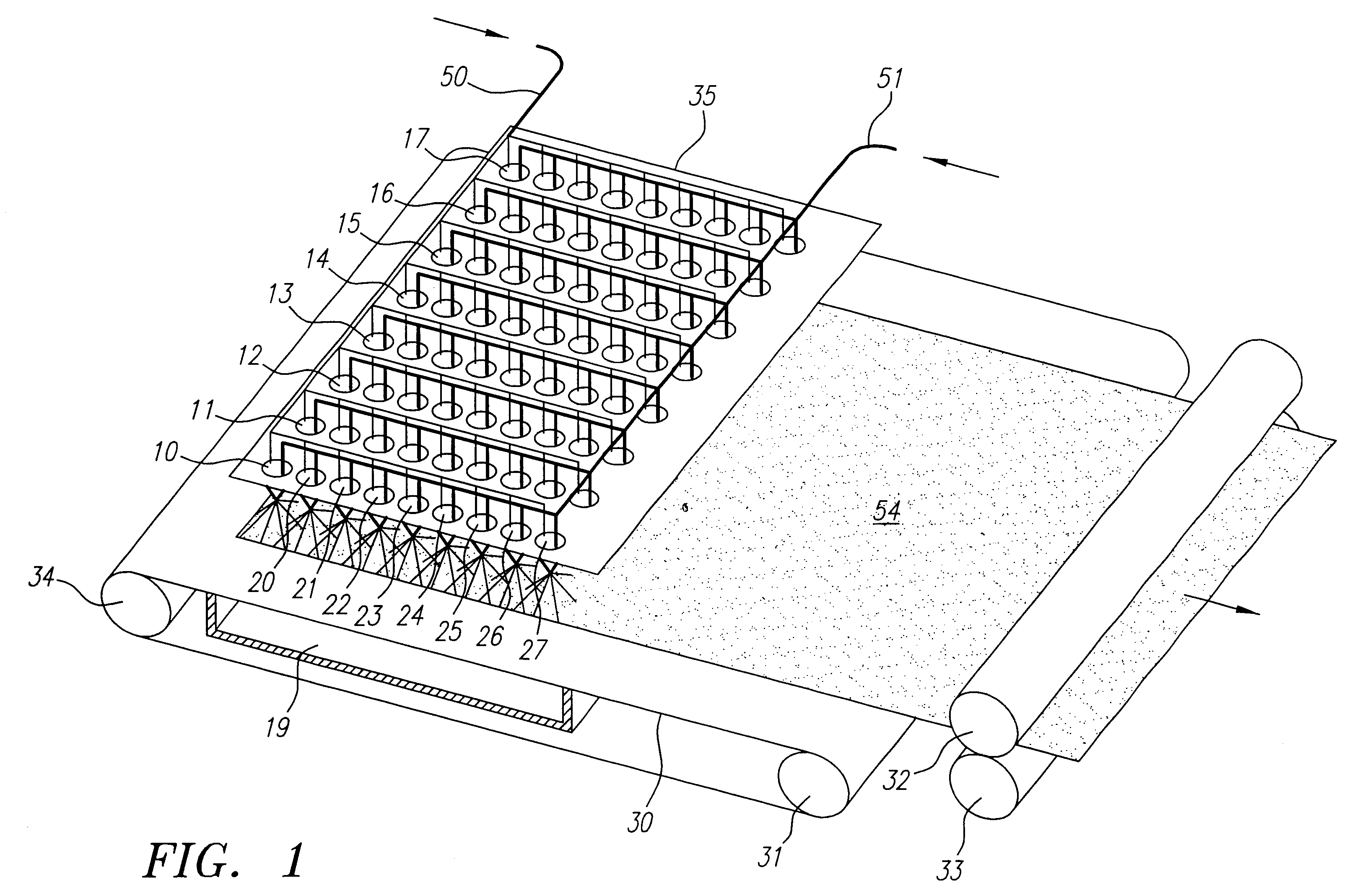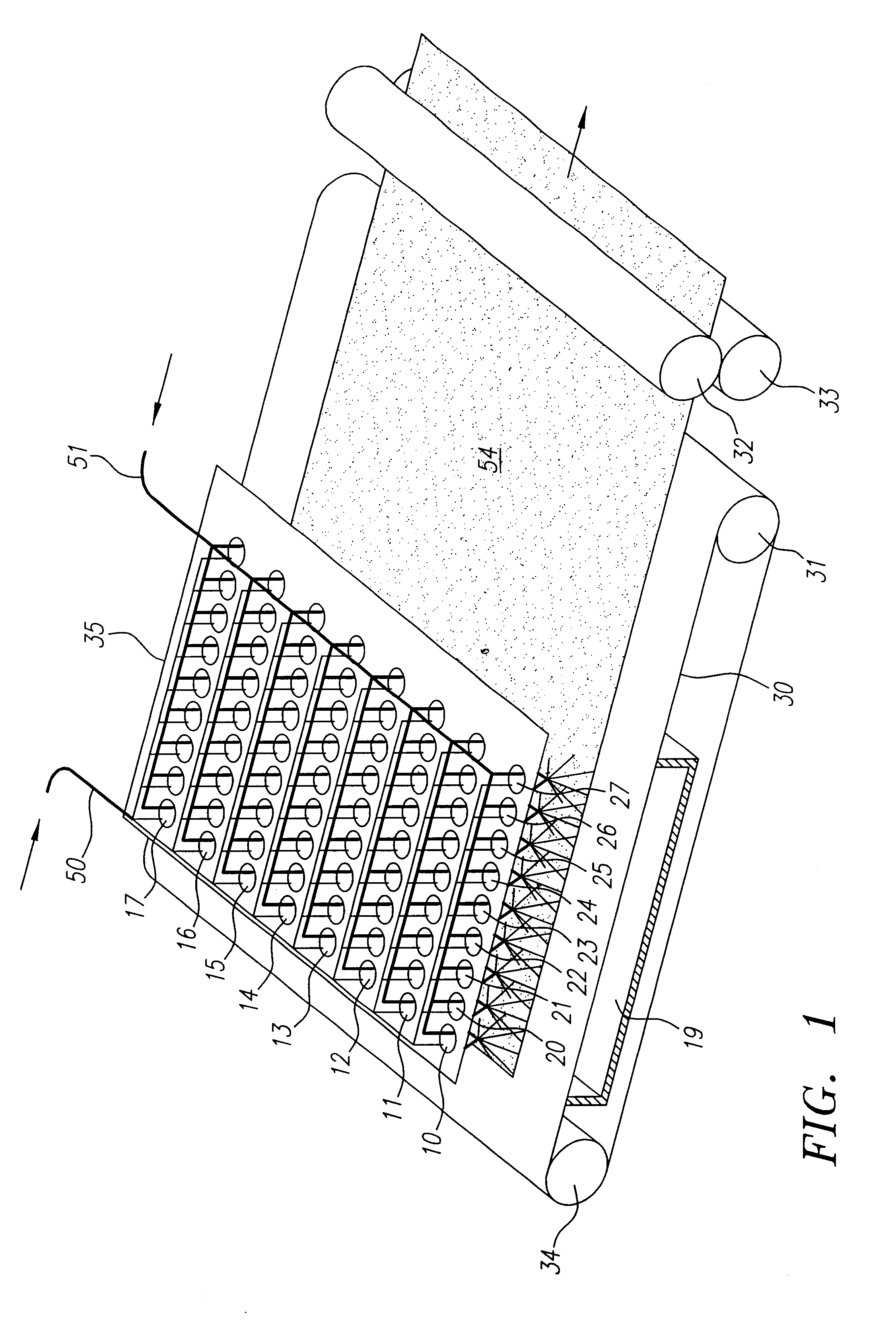However, most of these media lose efficiency rapidly or increase in price and investment and operating costs, as particle filtrate size decreases.
A major portion of such increased cost is due to costs associated with the increased resistance of the filter to air flow as the efficiency of particle removal is increased.
This creates a higher pressure drop for movement of air through the filter thereby imposing a greater work requirement upon the filter fan.
This, in turn, can require the use of larger and more costly fans which consume greater amounts of energy which can make the entire process economically prohibitive.
Also, filters capable of removing sub-micron diameter particles generally tend to rapidly plug up, necessitating frequent and costly filter replacement.
A number of significant problems, however, have inhibited the use appreciable quantities of sub-micron fibers in
filter media.
For example, one problem has been the difficulty of achieving uniform deposition of sub-micron diameter polymeric fibers onto a collecting surface.
Further, the stray fibers can damage or impair the filter production equipment.
Another problem inhibiting the use of appreciable quantities of sub-micron diameter polymeric fibers in
filter media results from the greater tendency of polymeric sub-micron diameter fibers to attach to each other in flight during formation, forming undesired loose clumps, "ropes" or other agglomerates.
The agglomeration problem is exacerbated by the presence of twisting and recirculating vortices in the
ambient air which tend to twist the agglomerates into ropelike structures.
The agglomerates eventually settle onto the formed
fiber web where they constitute a source of significant non-uniformity.
Another problem inhibiting the use of appreciable quantities of sub-micron diameter polymeric fibers in filter media results from the tendency of sub-micron diameter fibers to exhibit poor overall web mechanical properties and lack of self-support.
Sub-micron diameter fibers tend to only poorly attach to each other and are thereby susceptible to being lifted off and blown away by air currents associated with
fiber production.
Also, when such fiber webs are used as air filters, significant quantities of the sub-micron fibers are carried away intermittently by the air being purified.
Yet another problem retarding the use of sub-micron diameter polymeric fiber filtration media is the difficulty of uniformly distributing the ultra-fine fibers in the fiber web.
Moreover, because the higher surface area associated with each region of high concentrations of the sub-micron diameter fibers imparts to it a relatively
high resistance to air flow compared to regions of low concentrations, the ultra-fine fibers in these regions tend to be bypassed by the air being filtered, thereby reducing their effectiveness.
In addition to non-uniform distribution over the length and width of the fiber web, there is also a tendency for the sub-micron diameter fibers to collect at a certain depth of the fiber web.
This results in premature plugging of the filter, since most of the solids separated by the filter collect in a thin plane.
However, experiences with
asbestos fibers has led to concerns about the possibility of adverse health effects resulting from the
inhalation of such fine glass fibers.
They constitute a
hazardous waste which must be handled, at considerable expense and risk, in land fills.
In response to these concerns, filtration media made from polymeric materials composed of fibers larger in diameter than their glass counterparts are displacing glass media, notwithstanding the poorer performance characteristics of the larger diameter
polymer fibers.
However, Buntin further notes that very low
melt viscosity and very high gas velocities are required to make even a small fraction of sub-micron diameter fibers.
Buntin reports that the required gas blast caused "extreme"
fiber breakage and caused many fibers to be blown away from the laydown zone so that the fibers produced could not be incorporated into a practical fibrous web.
Further, the large amount of heated gas required in the process reported by Buntin tended to make melt-blowing uneconomical for sub-micron diameter fiber production.
(U.S. Pat. No. 5,207,970) report increased difficulty in obtaining webs having uniform properties as the blast air rates were increased.
In addition to uniformity, the melt-blowing processes do not have means to overcome the combined problems of web
weakness, fiber agglomeration and tendency for detachment from the web inherently associated with sub-micron fibers.
The use of self-supporting porous
layers of materials to overcome the inherent
weakness of sub-micron fibers does not alleviated the problems of clumping, roping, segregation, and entrainment in stray air currents which occurs with sub-micron fibers prior to deposition on any surface.
Even when the combination has macroscopic good strength, the weak inner core of sub-micron fibers has been found to develop cracks and regions of separation in the vibration that occurs in certain filter uses, due to local
weakness of the fiber-to-fiber bonds.
This allowed the air to be filtered to bypass or "short" through the filter, with a corresponding degradation of performance to an unacceptable level.
In addition,
calendering with a pressure sufficient to cause fiber-to-fiber fusion and the use of bonding agents can tend to result in excessive degradation of filtration performance when applied to sub-micron fibers.
Where a binder is used, the
high surface area of the sub-micron fibers causes them to soak up too much binder and become partially clogged.
Ahmed points out, however, that such arrangements lead to
layers which are poorly attached to each other, unless the fiber
bed thickness is considerably greater than the thickness required by filtration media.
Poor attachment of the structure forming
layers to the layer of weak fibers would mean that the weak layer would be unprotected with respect to fibrous web tensile forces.
The poor attachment of the layers as one reduces
fiber diameter results, in part, from the inability to space the conventional melt-blowing dies close to one another in the down
stream direction.
This suggests that adaption of melt-blowing geometries for the commercial production of sub-micron diameter fibers would be prohibitively expensive both in operating and equipment costs.
It would be impractical to attempt to adapt this method to the production of intermixed fibers of sub-micron diameter fibers with fibers large enough in diameter to be reinforcing, since it would require the close spacing of blast jets with one or two orders of magnitude difference in velocity.
Also, the high blast velocities required to form sub-micron fibers tend to blow the bulk of the relatively large
cellulose fibers away.
Binders in the form of
particulates tend to plug filtration surfaces, however.
It would be difficult to adapt this procedure to sub-micron fibers since they would be in a clumped state upon collection prior to mixing, and the required uniformity of dispersion for an efficient filtration web would be difficult to establish.
While this method may be applicable to relatively large fibers, sub-micron fibers clump together when placed in contact with each other and it would be impractical to attempt to separate them after their collection and attempt to distribute them in a web containing larger fibers.
Also the gross inter-mixing of sub-micron fibers with the larger fibers can cause discontinuities in the bonds between the larger fibers so that the resulting web would be too weak for use as a practical filter medium.
Unfortunately
solvent based processes are prohibitively expensive for general use.
In addition, the solvents can present the potential for
pollution if they escape the enclosures of the process.
Unfortunately electrostatic charge may leak away during storage or use of polymeric fiber media made from relatively large diameter fibers.
Consequently, the interior volume of the filter may not be used efficiently, resulting in a relatively low dust holding capability.
None of these examples disclose practical methods for preparing commercial-sized sheets of composite fibrous webs of polymeric materials which contain significant quantities of uniformly distributed and attached sub-micron diameter fibers.
 Login to View More
Login to View More 


